Chao Peng
AdaGReS:Adaptive Greedy Context Selection via Redundancy-Aware Scoring for Token-Budgeted RAG
Dec 31, 2025Abstract:Retrieval-augmented generation (RAG) is highly sensitive to the quality of selected context, yet standard top-k retrieval often returns redundant or near-duplicate chunks that waste token budget and degrade downstream generation. We present AdaGReS, a redundancy-aware context selection framework for token-budgeted RAG that optimizes a set-level objective combining query-chunk relevance and intra-set redundancy penalties. AdaGReS performs greedy selection under a token-budget constraint using marginal gains derived from the objective, and introduces a closed-form, instance-adaptive calibration of the relevance-redundancy trade-off parameter to eliminate manual tuning and adapt to candidate-pool statistics and budget limits. We further provide a theoretical analysis showing that the proposed objective exhibits epsilon-approximate submodularity under practical embedding similarity conditions, yielding near-optimality guarantees for greedy selection. Experiments on open-domain question answering (Natural Questions) and a high-redundancy biomedical (drug) corpus demonstrate consistent improvements in redundancy control and context quality, translating to better end-to-end answer quality and robustness across settings.
Benchmarking LLMs for Fine-Grained Code Review with Enriched Context in Practice
Nov 10, 2025



Abstract:Code review is a cornerstone of software quality assurance, and recent advances in Large Language Models (LLMs) have shown promise in automating this process. However, existing benchmarks for LLM-based code review face three major limitations. (1) Lack of semantic context: most benchmarks provide only code diffs without textual information such as issue descriptions, which are crucial for understanding developer intent. (2) Data quality issues: without rigorous validation, many samples are noisy-e.g., reviews on outdated or irrelevant code-reducing evaluation reliability. (3) Coarse granularity: most benchmarks operate at the file or commit level, overlooking the fine-grained, line-level reasoning essential for precise review. We introduce ContextCRBench, a high-quality, context-rich benchmark for fine-grained LLM evaluation in code review. Our construction pipeline comprises: (1) Raw Data Crawling, collecting 153.7K issues and pull requests from top-tier repositories; (2) Comprehensive Context Extraction, linking issue-PR pairs for textual context and extracting the full surrounding function or class for code context; and (3) Multi-stage Data Filtering, combining rule-based and LLM-based validation to remove outdated, malformed, or low-value samples, resulting in 67,910 context-enriched entries. ContextCRBench supports three evaluation scenarios aligned with the review workflow: (1) hunk-level quality assessment, (2) line-level defect localization, and (3) line-level comment generation. Evaluating eight leading LLMs (four closed-source and four open-source) reveals that textual context yields greater performance gains than code context alone, while current LLMs remain far from human-level review ability. Deployed at ByteDance, ContextCRBench drives a self-evolving code review system, improving performance by 61.98% and demonstrating its robustness and industrial utility.
Scalable Supervising Software Agents with Patch Reasoner
Oct 26, 2025



Abstract:While large language model agents have advanced software engineering tasks, the unscalable nature of existing test-based supervision is limiting the potential improvement of data scaling. The reason is twofold: (1) building and running test sandbox is rather heavy and fragile, and (2) data with high-coverage tests is naturally rare and threatened by test hacking via edge cases. In this paper, we propose R4P, a patch verifier model to provide scalable rewards for training and testing SWE agents via reasoning. We consider that patch verification is fundamentally a reasoning task, mirroring how human repository maintainers review patches without writing and running new reproduction tests. To obtain sufficient reference and reduce the risk of reward hacking, R4P uses a group-wise objective for RL training, enabling it to verify multiple patches against each other's modification and gain a dense reward for stable training. R4P achieves 72.2% Acc. for verifying patches from SWE-bench-verified, surpassing OpenAI o3. To demonstrate R4P's practicality, we design and train a lite scaffold, Mini-SE, with pure reinforcement learning where all rewards are derived from R4P. As a result, Mini-SE achieves 26.2% Pass@1 on SWE-bench-verified, showing a 10.0% improvement over the original Qwen3-32B. This can be further improved to 32.8% with R4P for test-time scaling. Furthermore, R4P verifies patches within a second, 50x faster than testing on average. The stable scaling curves of rewards and accuracy along with high efficiency reflect R4P's practicality.
SafeGenBench: A Benchmark Framework for Security Vulnerability Detection in LLM-Generated Code
Jun 06, 2025Abstract:The code generation capabilities of large language models(LLMs) have emerged as a critical dimension in evaluating their overall performance. However, prior research has largely overlooked the security risks inherent in the generated code. In this work, we introduce \benchmark, a benchmark specifically designed to assess the security of LLM-generated code. The dataset encompasses a wide range of common software development scenarios and vulnerability types. Building upon this benchmark, we develop an automatic evaluation framework that leverages both static application security testing(SAST) and LLM-based judging to assess the presence of security vulnerabilities in model-generated code. Through the empirical evaluation of state-of-the-art LLMs on \benchmark, we reveal notable deficiencies in their ability to produce vulnerability-free code. Our findings highlight pressing challenges and offer actionable insights for future advancements in the secure code generation performance of LLMs. The data and code will be released soon.
CodeVisionary: An Agent-based Framework for Evaluating Large Language Models in Code Generation
Apr 18, 2025Abstract:Large language models (LLMs) have demonstrated strong capabilities in code generation, underscoring the critical need for rigorous and comprehensive evaluation. Existing evaluation approaches fall into three categories, including human-centered, metric-based, and LLM-based. Considering that human-centered approaches are labour-intensive and metric-based ones overly rely on reference answers, LLM-based approaches are gaining increasing attention due to their stronger contextual understanding capabilities and superior efficiency. However, the performance of LLM-based approaches remains limited due to: (1) lack of multisource domain knowledge, and (2) insufficient comprehension of complex code. To mitigate the limitations, we propose CodeVisionary, the first LLM-based agent framework for evaluating LLMs in code generation. CodeVisionary consists of two stages: (1) Multiscore knowledge analysis stage, which aims to gather multisource and comprehensive domain knowledge by formulating and executing a stepwise evaluation plan. (2) Negotiation-based scoring stage, which involves multiple judges engaging in discussions to better comprehend the complex code and reach a consensus on the evaluation score. Extensive experiments demonstrate that CodeVisionary achieves the best performance for evaluating LLMs in code generation, outperforming the best baseline methods with average improvements of 0.202, 0.139, and 0.117 in Pearson, Spearman, and Kendall-Tau coefficients, respectively. Besides, CodeVisionary provides detailed evaluation reports, which assist developers in identifying shortcomings and making improvements. The resources of CodeVisionary are available at https://anonymous.4open.science/r/CodeVisionary.
Process Reward Modeling with Entropy-Driven Uncertainty
Mar 28, 2025



Abstract:This paper presents the Entropy-Driven Unified Process Reward Model (EDU-PRM), a novel framework that approximates state-of-the-art performance in process supervision while drastically reducing training costs. EDU-PRM introduces an entropy-guided dynamic step partitioning mechanism, using logit distribution entropy to pinpoint high-uncertainty regions during token generation dynamically. This self-assessment capability enables precise step-level feedback without manual fine-grained annotation, addressing a critical challenge in process supervision. Experiments on the Qwen2.5-72B model with only 7,500 EDU-PRM-generated training queries demonstrate accuracy closely approximating the full Qwen2.5-72B-PRM (71.1% vs. 71.6%), achieving a 98% reduction in query cost compared to prior methods. This work establishes EDU-PRM as an efficient approach for scalable process reward model training.
SoRFT: Issue Resolving with Subtask-oriented Reinforced Fine-Tuning
Feb 27, 2025



Abstract:Mainstream issue-resolving frameworks predominantly rely on commercial models, leading to high costs and privacy concerns. Existing training approaches for issue resolving struggle with poor generalization and fail to fully leverage open-source development resources. We propose Subtask-oriented Reinforced Fine-Tuning (SoRFT), a novel training approach to enhance the issue resolving capability of LLMs. We decomposes issue resolving into structured subtasks: file localization, function localization, line localization, and code edit generation. SoRFT consists of two training stages: (1) rejection-sampled supervised fine-tuning, Chain of Thought (CoT) data is filtered using ground-truth before fine-tuning the LLM, and (2) rule-based reinforcement learning, which leverages PPO with ground-truth based rewards. We evaluate the SoRFT-trained model on SWE-Bench Verified and SWE-Bench Lite, achieving state-of-the-art (SOTA) performance among open-source models (e.g., resolve 21.4% issues on SWE-Bench Verified with SoRFT-Qwen-7B). The experimental results demonstrate that SoRFT significantly enhances issue-resolving performance, improves model generalization, and provides a cost-efficient alternative to commercial models.
An LLM-based Agent for Reliable Docker Environment Configuration
Feb 19, 2025Abstract:Environment configuration is a critical yet time-consuming step in software development, especially when dealing with unfamiliar code repositories. While Large Language Models (LLMs) demonstrate the potential to accomplish software engineering tasks, existing methods for environment configuration often rely on manual efforts or fragile scripts, leading to inefficiencies and unreliable outcomes. We introduce Repo2Run, the first LLM-based agent designed to fully automate environment configuration and generate executable Dockerfiles for arbitrary Python repositories. We address two major challenges: (1) enabling the LLM agent to configure environments within isolated Docker containers, and (2) ensuring the successful configuration process is recorded and accurately transferred to a Dockerfile without error. To achieve this, we propose atomic configuration synthesis, featuring a dual-environment architecture (internal and external environment) with a rollback mechanism to prevent environment "pollution" from failed commands, guaranteeing atomic execution (execute fully or not at all) and a Dockerfile generator to transfer successful configuration steps into runnable Dockerfiles. We evaluate Repo2Run~on our proposed benchmark of 420 recent Python repositories with unit tests, where it achieves an 86.0% success rate, outperforming the best baseline by 63.9%.
Open-Book Neural Algorithmic Reasoning
Dec 30, 2024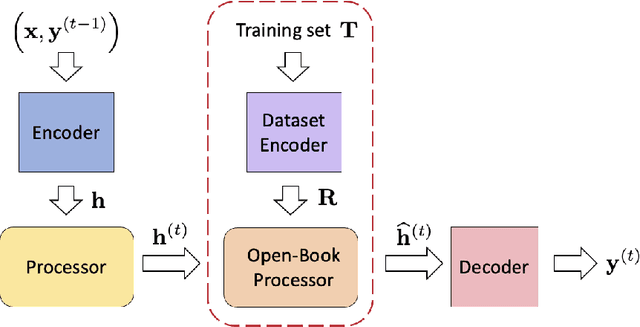
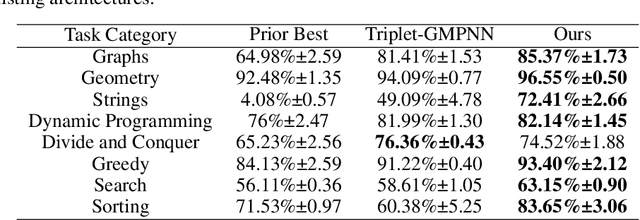
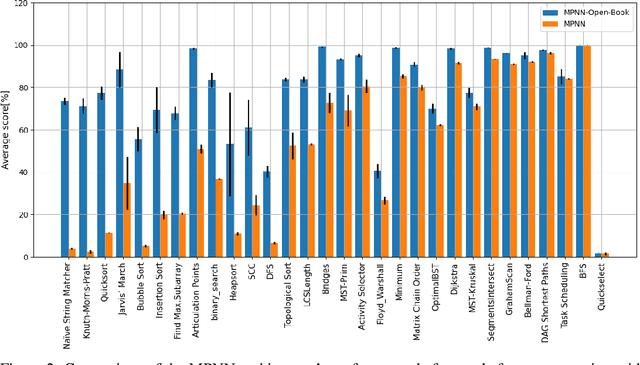
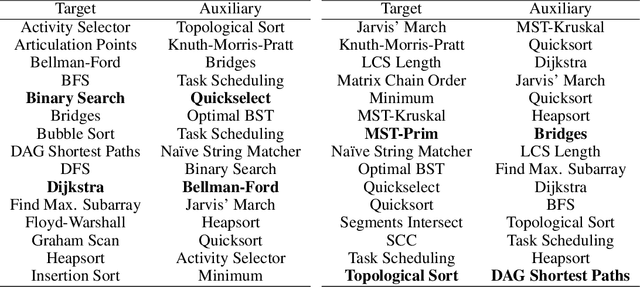
Abstract:Neural algorithmic reasoning is an emerging area of machine learning that focuses on building neural networks capable of solving complex algorithmic tasks. Recent advancements predominantly follow the standard supervised learning paradigm -- feeding an individual problem instance into the network each time and training it to approximate the execution steps of a classical algorithm. We challenge this mode and propose a novel open-book learning framework. In this framework, whether during training or testing, the network can access and utilize all instances in the training dataset when reasoning for a given instance. Empirical evaluation is conducted on the challenging CLRS Algorithmic Reasoning Benchmark, which consists of 30 diverse algorithmic tasks. Our open-book learning framework exhibits a significant enhancement in neural reasoning capabilities. Further, we notice that there is recent literature suggesting that multi-task training on CLRS can improve the reasoning accuracy of certain tasks, implying intrinsic connections between different algorithmic tasks. We delve into this direction via the open-book framework. When the network reasons for a specific task, we enable it to aggregate information from training instances of other tasks in an attention-based manner. We show that this open-book attention mechanism offers insights into the inherent relationships among various tasks in the benchmark and provides a robust tool for interpretable multi-task training.
CodeRepoQA: A Large-scale Benchmark for Software Engineering Question Answering
Dec 19, 2024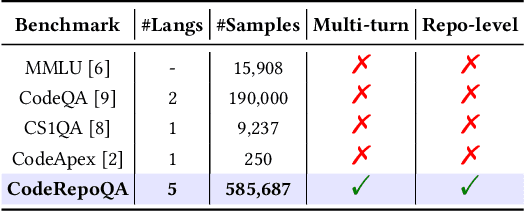
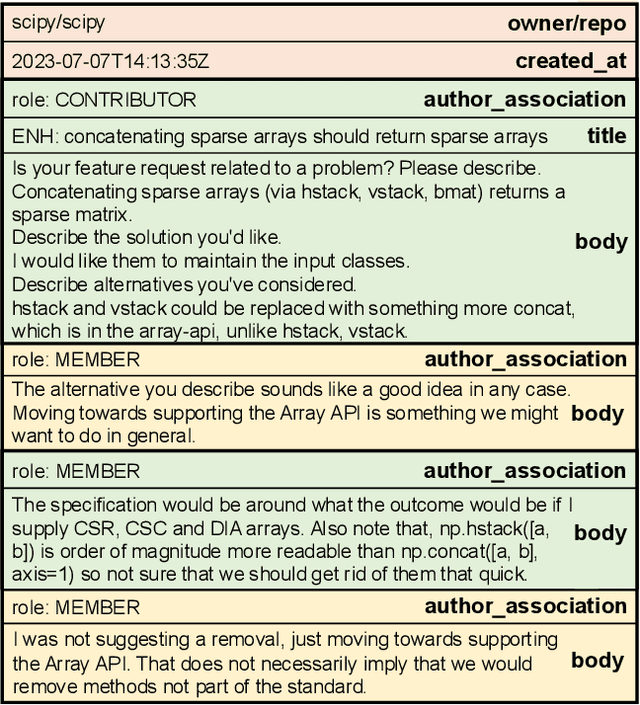


Abstract:In this work, we introduce CodeRepoQA, a large-scale benchmark specifically designed for evaluating repository-level question-answering capabilities in the field of software engineering. CodeRepoQA encompasses five programming languages and covers a wide range of scenarios, enabling comprehensive evaluation of language models. To construct this dataset, we crawl data from 30 well-known repositories in GitHub, the largest platform for hosting and collaborating on code, and carefully filter raw data. In total, CodeRepoQA is a multi-turn question-answering benchmark with 585,687 entries, covering a diverse array of software engineering scenarios, with an average of 6.62 dialogue turns per entry. We evaluate ten popular large language models on our dataset and provide in-depth analysis. We find that LLMs still have limitations in question-answering capabilities in the field of software engineering, and medium-length contexts are more conducive to LLMs' performance. The entire benchmark is publicly available at https://github.com/kinesiatricssxilm14/CodeRepoQA.
 Add to Chrome
Add to Chrome Add to Firefox
Add to Firefox Add to Edge
Add to Edge